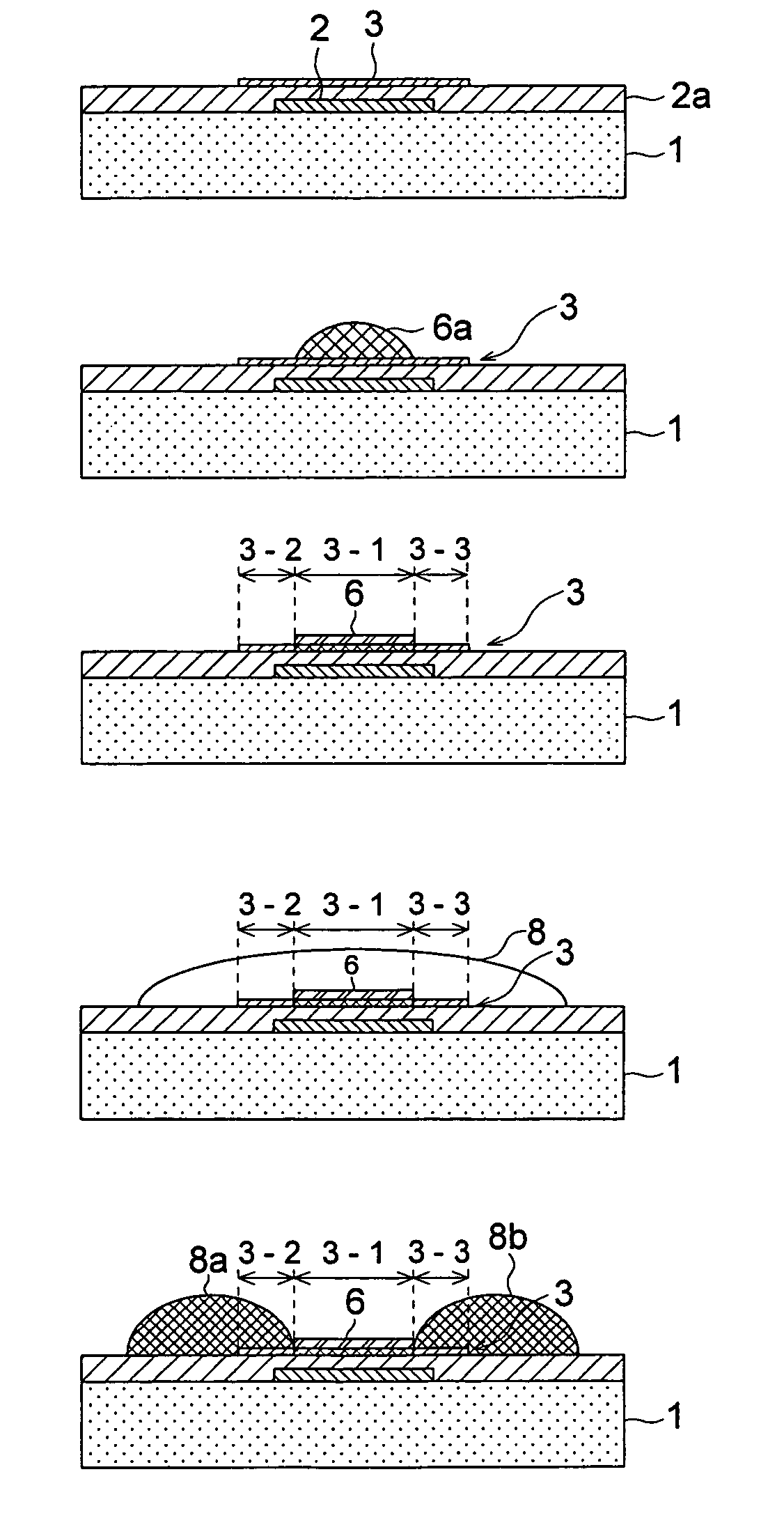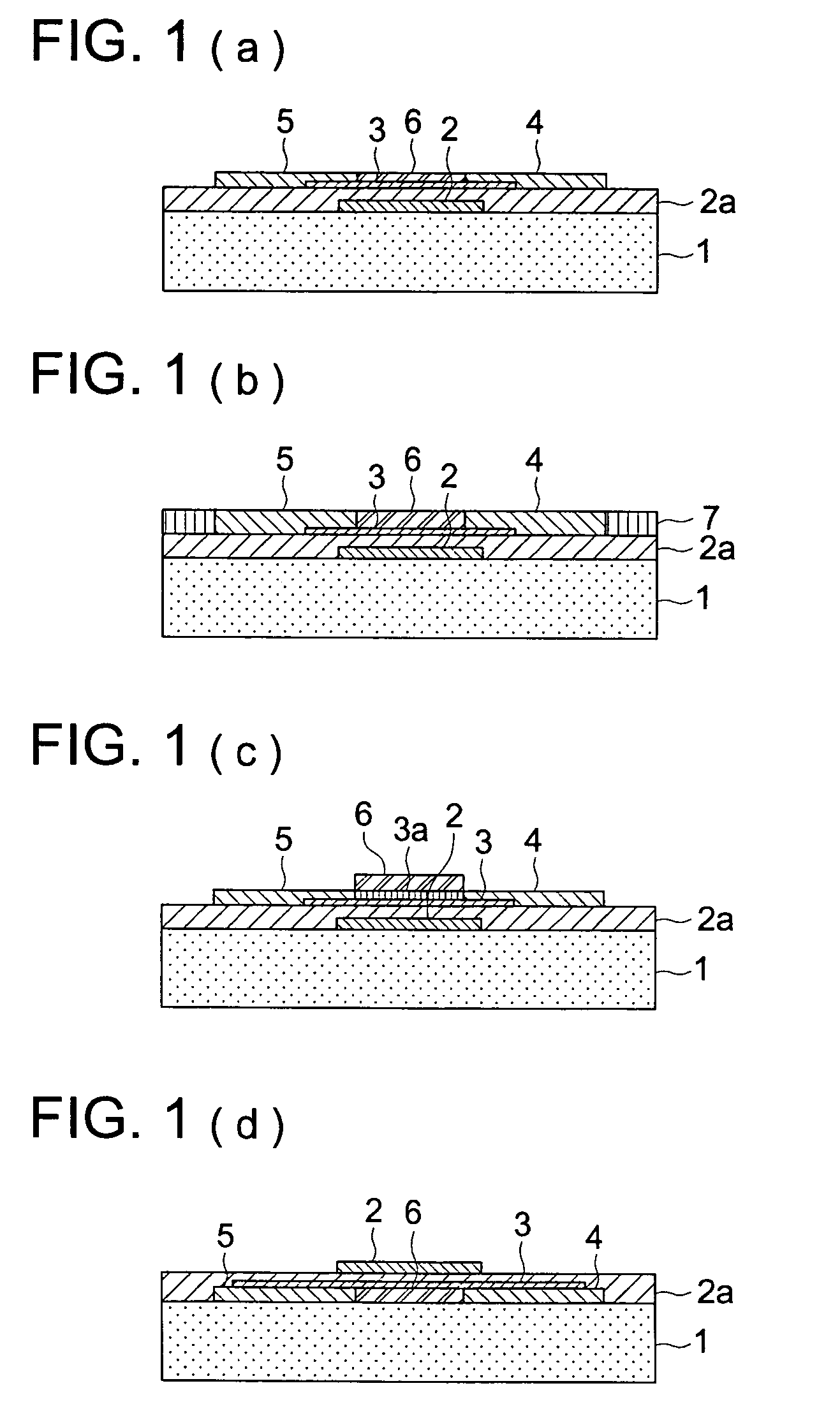Manufacturing method of thin-film transistor, thin-film transistor sheet, and electric circuit
a manufacturing method and technology of thin-film transistors, applied in the direction of transistors, solid-state devices, semiconductor devices, etc., can solve the problems of large-scale display panels, poor channel accuracy, and large increase in manufacturing costs or running costs, so as to facilitate and efficiently manufacture, the effect of minimizing the fluctuation of their performance and high accuracy
- Summary
- Abstract
- Description
- Claims
- Application Information
AI Technical Summary
Benefits of technology
Problems solved by technology
Method used
Image
Examples
example 1
>Bottom Gate Type
[0288]A thin-film transistor sample 1, having a layer structure as shown in FIG. 1(a), was prepared according to the following procedures.
[0289]In the procedures, procedures 1 through 3 will be explained employing FIG. 3(1) through 3(6). FIG. 1(a) has the same structure as FIG. 3(6).
Procedure 1: FIG. 3(1) Gate electrode 2, gate insulating layer 2a, and organic semiconductor layer 3 were provided on a substrate 1 as follows to obtain a layer structure as shown in FIG. 3(1).
[0290]The surface of substrate 1 of a 200 μm thick PES film was corona discharged at 50 W / m2 / min and then coated with a coating liquid having the following composition to obtain a layer of a dry thickness of 2 μm. The resulting layer was dried at 50° C. for 5 minutes, and hardened by being exposed for 4 seconds employing a 60 W / cm high pressure mercury lamp 10 cm distant from the layer.
[0291]
Dipentaerythritol hexacrylate monomer60 gDipentaerythritol hexacrylate dimmer20 gDipentaerythritol hexacryla...
example 2
[0314]Thin-film transistor sample 2 was prepared in the same manner as in thin-film transistor sample 1 of Example 1, except that the insulating area 6 was formed employing a composition, which was obtained kneading a mixture of the silicone adhesive and carbon (content ratio 2:1 by weight), instead of the silicone adhesive. The thin-film transistor sample 2 was evaluated in the same manner as in Example 1.
[0315]The thin-film transistor sample 2 exhibited the same good working property as thin-film transistor sample 1. A white light transmittance of the insulating layer of this sample 2 was 0.1%, and when the sample was operated under a fluorescent lamp of 3000 Lux, its property did not vary.
example 3
[0316]Thin-film transistor sample 3 was prepared in the same manner as in thin-film transistor sample 1 of Example 1, except that an organic semiconductor layer, a source electrode and a drain electrode were formed as follows:
1. Formation of Organic Semiconductor Layer
[0317]A chloroform solution of regioregular poly(3-hexylthiophene), (produced by Ardrich Co., Ltd.), which had been purified to have a Zn and Ni content of not more than 10 ppm, was prepared. This solution was ejected employing a piezo type ink jet printer, dried at room temperature and heat treated at 50° C. for 30 minutes in a nitrogen atmosphere to form an organic semiconductor layer of poly(3-hexylthiophene) with a thickness of 30 nm.
2. Formation of Source Electrode and Drain Electrode
[0318]A silver paste Dotite D-550 (produced by Fujikura Kasei Co., Ltd.) was coated on the insulating area, and dried to form a source electrode and a drain electrode.
[0319]The thin-film transistor sample 3 exhibited good working prop...
PUM
| Property | Measurement | Unit |
|---|---|---|
| thickness | aaaaa | aaaaa |
| thickness | aaaaa | aaaaa |
| light transmittance | aaaaa | aaaaa |
Abstract
Description
Claims
Application Information
 Login to View More
Login to View More - R&D
- Intellectual Property
- Life Sciences
- Materials
- Tech Scout
- Unparalleled Data Quality
- Higher Quality Content
- 60% Fewer Hallucinations
Browse by: Latest US Patents, China's latest patents, Technical Efficacy Thesaurus, Application Domain, Technology Topic, Popular Technical Reports.
© 2025 PatSnap. All rights reserved.Legal|Privacy policy|Modern Slavery Act Transparency Statement|Sitemap|About US| Contact US: help@patsnap.com



